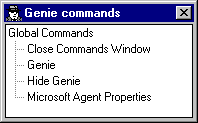
When a speech engine is installed and enabled, Microsoft Agent also includes a special interface called the Commands Window. This window displays the voice-enabled commands defined by the client applications for a character.

Figure 1. Commands Window
The Commands Window appears when the Open Commands Window command is chosen. Client commands appear in the Commands Window based on the Caption and Voice property settings of their Commands collection object.
The server creates a set of voice commands for general interaction and displays these under the Global Commands entry.
| Caption | Voice Grammar |
| Open | Close Commands Window | ((open | show) [the] commands [window] | what can I say [now]) toggles with: close [the] commands [window] |
| CharacterName | [show] CharacterName* |
| Hide All Characters | hide all [characters] |
| Hide CharacterName | hide CharacterName** |
| Microsoft Agent Properties | Close Microsoft Agent Property Sheet | [(open | show)] [microsoft] agent (properties | property sheet) toggles with: close [microsoft] agent (properties | property sheet) |
* All loaded characters are listed.
** A character is listed here only if it is currently visible.
The server automatically displays the commands of the current input-active client and, if necessary, scrolls the window to display as many of the client's commands as possible, based on the size of the window. If the character has no client entries, the Global Commands entry is expanded. Non-input-active clients appear in the tree as single entries.
Speaking the voice command for a client's Commands collection switches to that client and the Commands Window displays the commands of that client. No other entries are expanded. Similarly, if the user switches characters, the Commands Window changes to display the commands of its input-active client. If the client is already input-active, speaking its voice command has no effect. (However, if the user collapses the active client's subtree with the mouse, speaking the client name redisplays the client's subtree.) If a client has voice commands, but no Voice setting for its Commands object (or no Caption), the tree displays "(command undefined)" as the parent entry, but only when that client is input-active and the client has commands in its collection that have Caption and Voice settings. The server includes voice commands in the Global Commands entry ([show] [me] global commands). If the user speaks "Global Commands," the Commands Window always displays its associated subtree entries. If they are already displayed, the command has no effect.
Although you can also display or hide the Commands Window from your application's code using the Visible property, you cannot change the Commands Window size or location. The server maintains the Commands Window's properties based on the user's interaction with the window. Its initial location is immediately adjacent to the Microsoft Agent taskbar icon.
The Commands Window is included in the alt+tab window order. This enables a user to switch to the window to scroll, resize, or reposition the window with the keyboard.